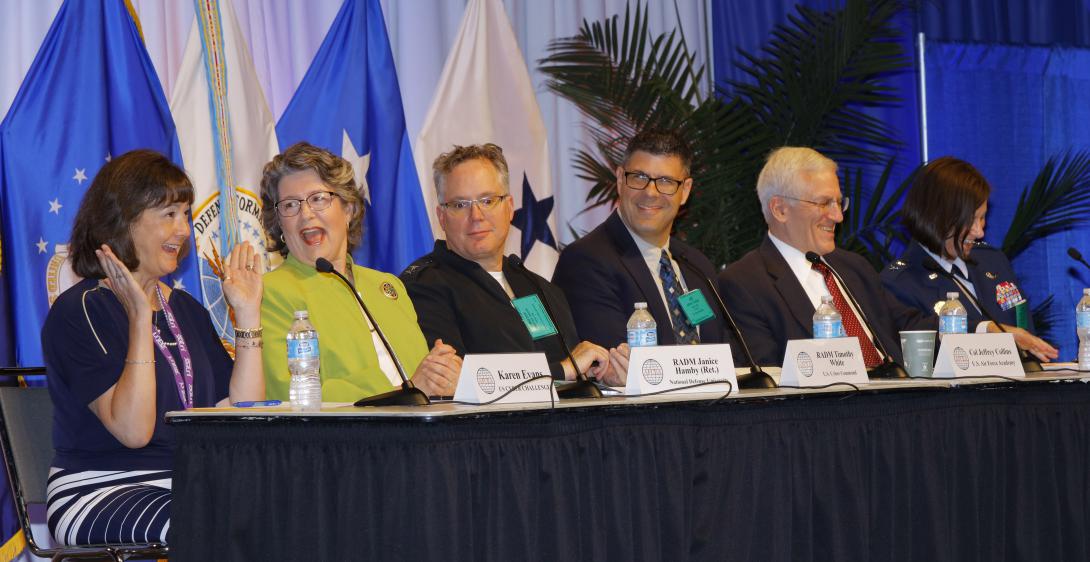Finding Cyber Talent in Unconventional Places
The struggle to hire cyber employees has increased with another ecosystem vying for the same shallow pool of qualified candidates.
The U.S. government’s primary competition for cyber work force talent is not with Silicon Valley—it’s with the struggling critical infrastructure sector woefully behind shoring up its cyber defenses, said Karen Evans, national director for the U.S. Cyber Challenge.
The struggles to hire and retain critical employees were made worse with the addition of yet another ecosystem vying for the same shallow pool of qualified cyber candidates, she said Thursday during a panel discussion at AFCEA International’s Defensive Cyber Operations Symposium, or DCOS. The three-day event, which concluded Thursday, was held in Baltimore.
The evolution of the cyber domain means government leaders must rethink how they train and retain a work force that will be capable of responding to new and evolving threats. The panel tackled the mounting demands and challenges of building a cadre of employees who are as talented as they are dedicated.
The cyber work force shortage issue is complicated by a generation that separates leaders from the overall employee base, said Rear Adm. Timothy White, USN, commander of Cyber National Mission Force (CNMF) at U.S. Cyber Command. The vast majority of his work force, for example, is younger than the age of 25. “I have a communications problem with my work force to a degree,” Adm. White jested.
Majority of Adm. White's CNMF work force under age of 25. 'i have a communcitation problem with my work force to a degree.' #AFCEACyber
— Sandra Jontz (@jontz_signalmag) June 15, 2017
The up-and-coming generation no longer is made up of digital natives—they are app natives, said Col. Jeffrey Collins, USAF, director of Air Force CyberWorx. CyberWorx is an Air Force-run entity focused on technological and human innovation in the cyber realm with emphasis on rapidly developing public-private partnerships.
Federal hiring criteria, particularly within the Defense Department, might be too stringent to attract the type of employees needed to build the force, said Maj. Gen. Sarah Zabel, USAF, vice director of the Defense Information Systems Agency (DISA).
Gen. Zabel: If characteristics are introverts & nonconformists, must DOD environment change to nurture that #cyber work force? #AFCEACyber
— Sandra Jontz (@jontz_signalmag) June 15, 2017
If the characteristics of future candidates includes introverts and nonconformists, it might be time for the DOD environment to change to accommodate them, Gen. Zabel said. Sometimes, those noncomforists might have a history they would otherwise be reluctant to disclose on job application forms, such as candidates who might have hacked a school library system to avoid paying for text books—an example shared by panelists. Should the government implement a don't ask don't tell policy for hacking, Gen. Zabel asked.
Work force Indicators that the #cyber world will be on the lookout for include those who are creative and have agility - #AFCEACyber
— Sandra Jontz (@jontz_signalmag) June 15, 2017
Additionally, the government is not going to get cyber defenders today from traditional science, technology, engineering and mathematics (STEM) programs, Evans said. Work force indicators for cyber include those who are creative and have the ability to easily adapt from one job to another and rapidly learn and excel at new jobs, Col. Collins added.
Not going to get defenders today from traditional #STEM programs, says Karen Evans, natl dir U.S. #Cyber Challenge - #AFCEACyber
— Sandra Jontz (@jontz_signalmag) June 15, 2017
Cybersecurity is not just about operators on keyboards, Adm. White offered. The dynamic field also includes analysts and linguists and logisticians.





Comments